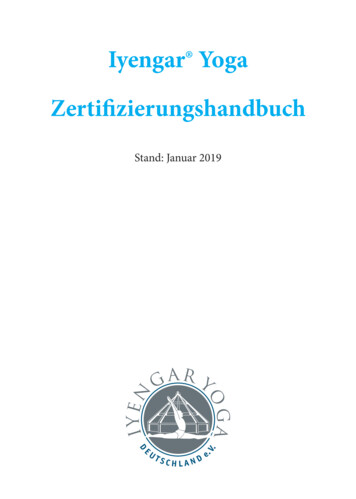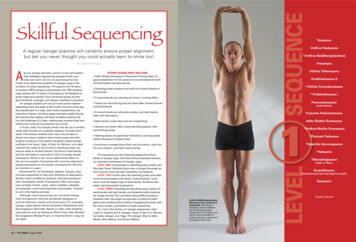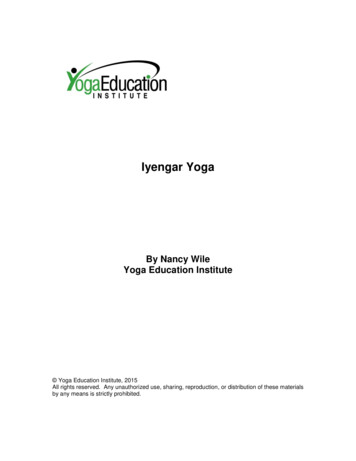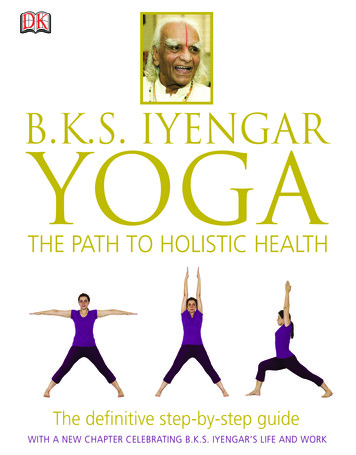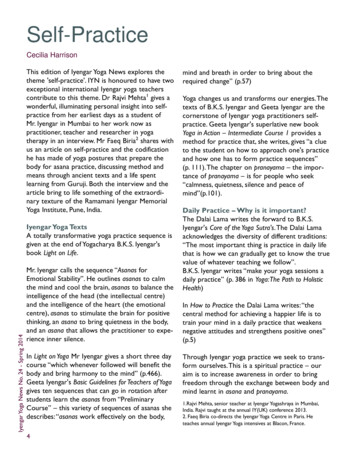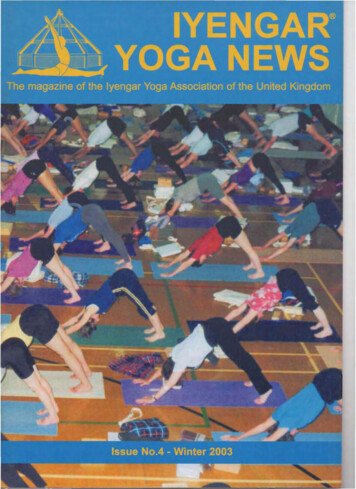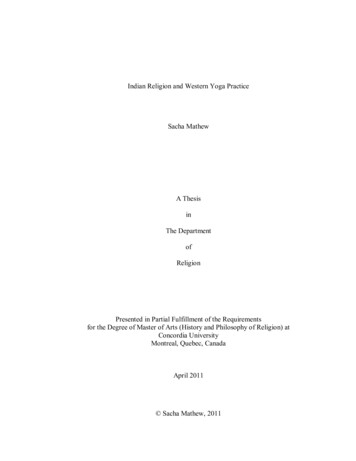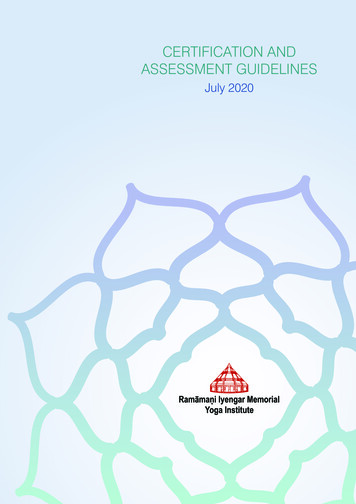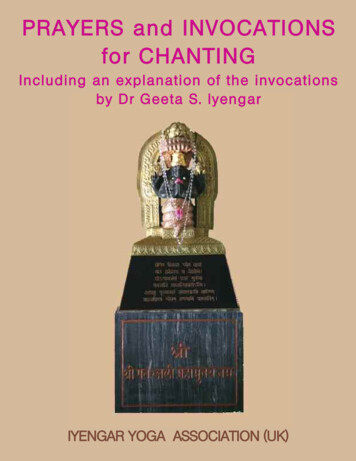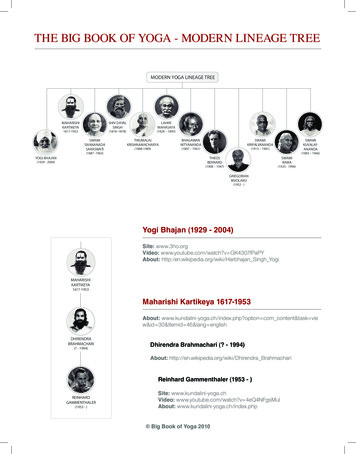
Transcription
Teacher Trainers’ ManualIY(UK)IYENGAR YOGA (UK)Honorary President: Yogacharya Sri B. K. S. Iyengarwww.iyengaryoga.org.ukAT REPORTIyengar Yoga Teaching Syllabus (Introductory Level)The Syllabus is in 3 sections1. Personal Practice 2. Teaching3. Theoretical KnowledgeCandidates will need to obtain a pass mark in each category to gain their certificate. During training and aftergaining the Introductory teaching certificate, candidates are expected to have an established regular practice ofall the Introductory syllabus asanas which they will be certified to teach and including also intermediate asanassuitable for their own level of practice. They will be expected to have an established regular practice of thepranayamas on the Introductory syllabus.Core Text BooksGeeta S. Iyengar, Yoga in Action Preliminary CourseB.K.S. Iyengar, Geeta S. Iyengar, Basic Guidelines for Teachers of YogaCore Reference BooksB.K.S. Iyengar, Light on Yoga, Light on Pranayama, Light on the Yoga Sutras of PatanjaliGeeta S. Iyengar, Yoga a Gem for WomenDefinitions of Concepts integral to the Syllabus and Personal Practice Marking CategoriesAlignment in a yogasana is to do with the position of the body in space and the position of its parts relative toeach other, and to the floor, the wall or any other props. Alignment has to be checked, and if necessary adjusted,after any movement, i.e. repositioning of any part of the body, for instance when moving from an intermediatestage of an asana to its final stage. Alignment therefore has to be considered at all stages of an asana;preparation, going into the pose, being in the pose, coming out of the pose.Extension in a yogasana is to do with the inner action of the pose. It includes, e.g.: the gradual, safe, noninjurious stretching of muscles, tendons and ligaments; the expansion and lift of the chest; the elongation of thelimbs and the trunk to create space in the joints; the lift of the trunk and inner organs. Extension is facilitatedby correct alignment and also interacts with it to improve alignment itself. Understanding of extension includesawareness of the possibility of over-extension as well as under-extension. It also includes bringing life andawareness to areas that are dull.Direction or Directionality in a yogasana is to do with the direction of an extension from its source or root,i.e. forward, backward, lateral, rotational.Steadiness & Stability in a yogasana is demonstrated by holding the pose quietly without shakiness or strain,by normal breathing and showing sensitivity to the breath and by demonstrating intelligent work with personaldifficulties.Precision in a yogasana is to do with the subtle adjustments to alignment and extension. It includes refining theinternal balance of a pose, understanding of directionality, showing potential towards understanding the innerwork of the postures and the mental and emotional elements in their practice.August 2016Page 1 of 13IYENGAR YOGA (UK) LTD Registered office address (not for correspondence): New Oaks, Southview Close, Crowborough, East Sussex, TN6 1HHRegistered in England and Wales No. 7827245B1
Teacher Trainers’ ManualIY(UK)List of Basic Postures (level 1) recommended for the first two terms of the course. Important asanas arein bold face.1. Tadasana2. Gomukhasana (arms only)3. Utkatasana4. Vrksasana5. Utthita Trikonasana6. Virabhadrasana 27. Utthita Parsvakonasana8. Virabhadrasana 19. Ardha Chandrasana10. Parighasana11. Parsvottanasana (arms down, head up)12. Prasarita Padottanasana 1 (concave back, head up)13. Uttanasana (concave back)14. Padangusthasana15. Padahastasana16. Adho Mukha Svanasana (support – for hands or heels)17. Dandasana18. Siddhasana19. Virasana20. Parvatasana21. Trianga Mukhaikapada Paschimottanasana22. Marichyasana 1 (twist only)23. Malasana 1 (a) (with or without wall support for back) – not shown at assessment24. Malasana 1 (b) (heels on rolled blanket) – shown at the assessment25. Bharadvajasana 1 (turning, without holding the upper arm)26. Chatushpadasana (see Yoga a Gem for Women pl. 102 and cf. LOY pl. 258)27. Salamba Sarvangasana28. Halasana (legs on stool or feet at wall, feet on floor in own practice)29. Karnapidasana30. Supta Konasana31. Setu Bandha Sarvangasana (on a brick/blocks)32. Urdhva Prasarita Padasana (90 only)33. Savasana (on bolster with eye band, observing the normal in breath and out breath)Pranayama assessed during training34. Ujjayi (stage 1 and 2)35. Viloma (stage 1 and 2)August 2016Page 2 of 13B1
Teacher Trainers’ ManualIY(UK)List of Postures to be introduced progressively over remaining training period (level 2). Important asanasare in bold .36.37.38.39.40.41.42.43.44.TadasanaUtthita ParsvakonasanaParivrtta TrikonasanaParivrtta ParsvakonasanaVirabhadrasana 3 (from a good Virabhadrasana 1)Parivrtta Ardha ChandrasanaParighasanaGarudasanaUtthita Hasta Padangusthasana 1 (with belt, leg forwards, heel support – wall or ledge)Parsvottanasana (final pose, hands in namaste if possible)Prasarita Padottanasana 1 (final pose)Uttanasana (final pose)Salamba Sirsasana (against a wall)/Rope SirsasanaSupta Virasana (supported and non-supported)Adho Mukha Svanasana (any appropriate support)Chaturanga DandasanaUrdhva Mukha SvanasanaBhujangasanaDhanurasanaSalabhasana and MakarasanaUstrasanaUrdhva Dhanurasana 1 (from chair or stool)Dwi Pada Viparita Dandasana (trunk supported on chair with edge of chair under shoulder blades – feetto wall, legs parallel to the floor)Bharadvajasana 1 (final pose)Bharadvajasana 2Marichyasana 3 (twist – opposite bent elbow over the bent knee)Ardha Matsyendrasana I (preparatory learning to sit on the foot, wall/foot support)Malasana 1 (heels down, arms gripping wall/column)Baddha Konasana (sitting straight)Upavistha Konasana (sitting straight)Janu SirsasanaMarichyasana 1 (bend forward with hands and arms entwined)Paschimottanasana (Ugrasana/Brahmacharyasana)Paripurna NavasanaArdha NavasanaSalamba Sarvangasana 1(5 minutes)Halasana (toes on floor, 3 minutes)Eka Pada SarvangasanaParsvaika Pada Sarvangasana (as far as possible)Parsva HalasanaSetu Bandha Sarvangasana (Uttana Mayurasana with support – i.e. lifting from the ground, hands inback, feet on wall/brick/stool, seeYoga a Gem for Women, pls. 97/98Supta Padangusthasana 1 and 2Supta Baddha KonasanaSavasana (eye band, normal inhalation and deep exhalation)Pranayama (assessed during training)45. Ujjayi (stages 3 and 4)46. Viloma (stage 3)47. Bhramari (supine)August 2016Page 3 of 13B1
Teacher Trainers’ ManualIY(UK)1. Personal PracticeTo take the assessment candidates should be of tidy and decent appearance and dressed in clothing whichpermits clear demonstration of asanas. Sanskrit names for all asanas on the syllabus should be known. Exceptwhere specified in the asana lists, only use props where absolutely necessary, e.g. to support an injury or toachieve a correct action that is not (yet) possible without the help of a prop. All standing asanas should beshown from Tadasana, through Utthita Hasta Padasana, unless stated otherwise; seated asanas should beginfrom Dandasana unless stated otherwise.During assessment, candidates should:1.Demonstrate understanding of correct alignment making adjustments as necessary to achieve this.2.Show work to improve extension in the pose – again making adjustments as necessary to achieve this.Show an understanding of the correct directionality of any extensions.3.After adjustments to alignment and extension hold the posture steadily in a quiet state of mind.4.Show awareness of personal problems (e.g. stiffness, injury) and demonstrate appropriate use of propswhere necessary.5.Be able to remain in Sarvangasana steadily for 5 minutes.6.Be able to remain in Sirsasana in good alignment steadily for 5 minutes, where possible and appropriatewithout the support of a wall. Students with postural problems, injuries, difficulty with alignment orbalance or who are fearful may use support. Those who normally practise with the help of a wall, corner,or supports for the shoulders must make this requirement clear to the presiding Moderator in advance ofthe assessment. Rope Sirsasana will not be assessed, but where possible candidates should familiarisethemselves with this variation in their own practice.When showing their own practice candidates should pay particular attention to the important points mentionedbelow.Personal Practice Marking Categories (see definitions above)-AlignmentExtensionSteadiness & StabilityPrecisionSirsasana and SarvangasanaBackward extensionsStanding PosesOther AsanasAll Categories will carry equal weight (MARKS out of 5)August 2016Page 4 of 13B1
Teacher Trainers’ ManualIY(UK)2. TeachingDuring assessment, candidates should be able to:1. Demonstrate the ability to improve alignment and extension in students. Correction may be either by verbalinstruction or physical adjustment providing it is effective, safe and sensitive to the student’s capability.2. Understand the directionality of a pose and how to adjust in intermediate stages in order to improvealignment and extension. Understand whether a student is ready to complete the pose or should remain atan intermediate stage.3. Demonstrate appropriate use of props to help students experiencing stiffness, instability or pain.4. Understand how to help students suffering from knee or back pain in poses marked *.5. Show good presentation, stand well and be able to give clear, simple and unambiguous instructions to theclass.6. Show good organisation in teaching the class and demonstrate awareness of the students and their needs.7. Clearly demonstrate on their own bodies points given to students.Teaching Marking Categories-Teaching of InversionsClarity of InstructionDemonstrating PerformanceObservation and CorrectionCare of StudentsControl of ClassDefinitions of Teaching Marking CategoriesTeaching of Sarvangasana/Halasana; Sirsasana (see p. 10).Clarity of Instruction - Speaking clearly and with sufficient volume and energy to be easily heard and followed.Giving precise, unambiguous instructions; not giving too much information. Candidates will be expected toteach with some detail and subtlety but when they do so their instructions must be straightforward and clear.Demonstrating Performance - Good presentation of asanas being taught. Ability to demonstrate on one’sown body to explain points. Ability to mirror the class. Good personal presentation when teaching, includingstanding well.Observation and Correction - Ability to recognise misalignment, poor directionality and lack of extension.Showing the ability to improve these through verbal instruction or, where appropriate, physical adjustment.Care of Students - Awareness of and sensitivity to individual needs, appropriate use of props where necessary.Safety and sensitivity in making adjustments.Control of Class - Commanding the attention of students, efficient organisation, especially when students areusing equipment, moving from one place to another or where individual students are being asked to workdifferently from the rest of the class.All categories will carry equal weight (MARKS out of 5).August 2016Page 5 of 13B1
Teacher Trainers’ ManualIY(UK)As well as alignment, directionality and extension in every posture, candidates should in particular be aware ofspecific points for each posture as set out below:Suggested guidelines for Basic AsanasTadasana Adjustment of feet, working from the base of the pose upwards. Extension of legs, action and/oralignment of tailbone, sacrum, diaphragm, ribcage, shoulder-blades, thoracic spine, neck and head and arms. Thealignment and connection of all these to be taken to all other standing poses.Gomukhasana (arms only) Correct opening of shoulders, control of lumbar spine. Use of belt.Vrksasana Levelness of pelvis, laterally and horizontally. Be able to help students having difficulty with balance.Utthita Trikonasana Attention to intermediate stages: (i) Correct distance between feet after jumping; (ii)Correct alignment and opening of chest (using support for lower hand if necessary).Ardha Chandrasana Be able to help students having difficulty with balance. Attention to method of going intoand coming out of the pose. Correct alignment of legs, hips, shoulder girdle, arms and head.Virabhadrasana 2 Correct distance between feet after jumping. Aim to bring bent leg to right angle withoutcollapsing the straight leg. Bent leg shin vertical. Even lift of the trunk.Utthita Parsvakonasana Attention to intermediate stages: (i) Correct distance between feet after jumping; (ii)Correct alignment of bent leg and hip and turn of chest before raising upper arm (using support for lower handif necessary).Utkatasana Correct extension of spine. Proper extension and lift of arms.Virabhadrasana 1 Correct distance between feet after jumping. Turn of the hips and trunk. Work in back leg.Vertical shin in front leg. Lift of trunk.Parighasana Attention to intermediate stages: (i) Correct distance between knee and foot (using support forfoot if necessary; (ii) Correct alignment and opening of chest before raising arm. Correct extension of spine.Lower arm may be straight or bent, upper arm must be straight.Parsvottanasana (arms down – head up) Levelness of hips. Extension of spine forwards. Opening of chest(using support for hands if necessary). Extension of legs.Prasarita Padottanasana 1 (concave back – head up) Lift in legs. Extension of spine forwards. Opening ofchest (using support for hands if necessary).Padangusthasana Lift in legs. Extension of trunk, opening of chest before bringing head down (using beltsround toes if necessary)Padahastasana Lift in legs. Extension of trunk, opening of chest before bringing head down (using raise undersoles and support for hands if necessary)Uttanasana (concave back) Lift in legs. Extension of trunk forward, lift and openness of chest (using supportfor hands if necessary).*Virasana Lift in the spine. Be able to help students with stiff hips and/or ankles or painful knees. Correctposition of feet.Parvatasana Lift of chest, control of lumbar spine. Correct extension of arms.Adho Mukha Svanasana (with support – for hands or heels) Understand and be able to explain use of wallsupport for hands and feet and extension of arms and legs.*Bharadvajasana 1 (turning, without holding the upper arm) Levelness of hips and shoulders. Evenextension of spine with turn.August 2016Page 6 of 13B1
Teacher Trainers’ ManualIY(UK)*Dandasana Lift in the spine. How to assist the lift of the lower back. Understanding of lift in chest.Extension of legs.*Siddhasana Lift in the spine. How to assist stiff hips, painful knees. Correct position of feet.*Trianga Mukhaikapada Paschimottanasana Levelness of hips, how to assist the lift of the lower back,extension of spine before bringing head down.Marichyasana 1 (twist only) Openness of chest and forward extension before clasping. Evenness of sides ofthe trunk when twisting. Use of belt if necessary.*Malasana Reason for and use of support for heels. Knees together or separate and coming forwards. Shouldalso understand use of wall for back, to support sacrum and encourage extension of trunk but this method notshown at assessment.Chatushpadasana Placement of feet. Work in legs, lift of hips. Extension of arms, expansion of chest. Aim forvertical shins – use of belt if necessarySalamba Sarvangasana 1 Correct position of head/shoulders/arms/elbows. Show base correctly on equipment.Correct extensions particularly the back chest and the legs .Alignment of the pose from the side/back/front.Face/neck showing no pressure.Halasana Maintain base of arms/shoulders/trunk as for Sarvangasana 1 - extension of legs.Karnapidasana equal extension and lift of spine, keep neck free of strainSupta Konasana equal extension and lift of spine, lift and extension of legs, upper arms from elbow toshoulder in firm contact with the baseSetu Bandha Sarvangasana (on a brick/blocks) Care going into and coming out of posture. Properextension in spine, work in legs, opening and lift of chest. Feet at the wall.*Urdhva Prasarita Padasana (90 ) How to assist stiff hamstrings. Understanding of lift in chest.* see page 5 item 4Guidelines for ProgressionGarudasana Free standing in personal practice. Chest lifted hips level. How to assist a student with i) balance;ii) stiff shoulders/arms; iii) stiff hips/legs.Virabhadrasana 3 Proper extension of arms, trunk and back leg. Openness of chest. How to assist a studenthaving difficulty with (a) balance (b) alignment. In personal practice from Virabhadrasana 1. In teaching may bedone with support but full pose should also be seen.Parivrtta Trikonasana, Parivrtta Parsvakonasana Intermediate stage: turn of hips and trunk. Extension ofback leg. Observe correct alignment and turn of trunk before raising upper arm (using support for lower hand ifnecessary). In personal practice heel support may be used for P. Trikonasana if this results in improvement. InP Parsvakonasana back heel lifts but pose should be started with heel down. Chest should not collapse if handis taken to floor.Parivrtta Ardha Chandrasana Correct alignment of legs, hips, trunk and head. Turn of trunk. Properextension of arms. How to assist a student having difficulty with (a) balance, (b) alignment. May be taught withfoot or back to wall.Utthita Hasta Padangusthasana 1 (with belt, leg forwards, heel support) Understand reason for and use ofsupport for heel of lifted leg. Use of belt. Levelness of hips. Lift and extension of standing leg.August 2016Page 7 of 13B1
Teacher Trainers’ ManualIY(UK)Parsvottanasana (hands in namaste if possible) Correct opening of shoulders. Work in arms to open chest.How to assist a student with stiff shoulders. Extension of back leg. Level hipsPrasarita Padottanasana 1 (final pose) Lift of legs. Extension of trunk down. Correct alignment of arms andshoulders. In personal practice and teaching go from Level 1 pose into Level 2 pose. Blocks may be used underhead if this creates improvement.Uttanasana (final pose) Extension of legs. Lengthening in side trunk and release of abdomen and diaphragm.Work in arms, passivity in neck. From Level 1 into Level 2. May be done with feet slightly apart. In teachingsupports may be used to maintain concavity at the intermediate stage.Salamba Sirsasana Correct position and actions of the hands/arms/head/shoulders/dorsal region. Extensionof the legs. Alignment of the pose from the side and the front/back views. Face and neck showing no pressure.*Supta Virasana Performed as a working asana, not recuperative. To be shown with & without support inpersonal practice unless candidate needs support because of stiffness or knee problems. When teaching, abilityto help students with stiffness, back or knee pain. Correct position of feet.Adho Mukha Svanasana (any appropriate support – personal practice to the candidate’s preference; whenteaching as they find the class) Understanding of use of different methods of support to help action in (i) hipsand legs; (ii) shoulders and arms; (iii) lift of trunk together with release of neck. Head descending, with orwithout support.Chaturanga Dandasana Extension of legs, action of tailbone. How to assist students who have difficultylifting; from floor if possible in own practice. May be done from Adho Mukha Svanasana or with blocks whenteaching.*Urdhva Mukha Svanasana Extension of arms and legs, lift of side trunk and opening of chest. How to assiststudents having difficulty lifting. May be done with toes tucked under when teaching & in practice for backproblems. Blocks may be used for hands*Bhujangasana Extension of legs. Action of arms to curve spine and open chest. Use of lifts if necessary.*Dhanurasana Extension and lift of thighs and shins. Action of legs and arms to lift chest.*Salabhasana and Makarasana Extension of legs which must be straight; how to assist this. Lift, extensionand curve of spine. Effect of different arm positions on lift of chest. If chosen, candidate will teach both poses.*Ustrasana Has to be done with tops of feet on floor. Action of shins, lift of thighs and extension of spine. Liftof chest. How to help students i) with neck problems; ii) who are unable to reach their heels with their hands.May be done with knees apart or together but must be taught with knees apart.*Urdhva Dhanurasana 1 (from chair or stool) Use of chair. Use of wall. Use of lift for hands & feet wherenecessary. How to help stiff students. Extension and lift of legs and arms.Dwi Pada Viparita Dandasana (on a chair – legs parallel to the floor) Use of support to lift chest, correctposition and extension of legs; heels pressing into a support. If wall is also used for the feet they must press intothe wall. Arms holding under chair or chair back. Know how to help students with neck problems.*Bharadvajasana 1 (final pose) Levelness of hips (support if necessary) and shoulders. Action of arms whenholding upper arm. Use of belt on upper arm if clasping not possible.*Bharadvajasana 2 Levelness of hips and shoulders. Even extension of spine with turn. How to help studentswith painful knees, use of belt and support if necessary.*Baddha Konasana Turn of legs. Lift of spine from base. How to assist stiff hips or painful knees.Upavistha Konasana (sitting straight) Extension of trunk. Alignment of feet and legs. Feet may be held ornot or belts on feet may be used, folded blanket for support rather than a block.August 2016Page 8 of 13B1
Teacher Trainers’ ManualIY(UK)*Janu Sirsasana How to protect bent knee, how to assist the lift of the lower back. Extension of straight leg.Extension and turn of trunk before bringing head down.Marichyasana 1 (bend forward with hands and arms entwined) How to assist the lift of the lower back.Openness of chest and forward extension before clasping. Extension of straight leg, action of bent leg and arms.Buttock of bent leg may lift to gain forward extension but must be encouraged to go down. Lifts and belts asnecessary when teaching.Malasana (heels down, arms to wall or other support) Reason for and use of wall (or chair).Marichyasana 3 (opposite bent elbow over bent knee) Intermediate stages: Evenness of buttock bones,using support to lift the lower back if necessary. Extension of straight leg, action of bent leg and arm. Seeingthat students can lift and rotate in chest; in personal practice lift and rotation in chest is required beforeentwining the arms.Ardha Matsyendrasana 1 (preparatory – sit on foot, wall/foot support) Correct placement of feet, use ofsupports, how to help students having difficulty with balance.*Paschimottanasana How to assist the lift of the lower back. Extension of legs. Extension of trunk beforebringing head down. May be taught with belt for feet or support for head.Paripurna Navasana Extension and lift of legs and lift of chest. Be able to help students having difficulty withbalance. Various methods and supports may be used when teaching but the final pose should be aimed for.Ardha Navasana Extension of legs. Be able to help students having difficulty with balance.Halasana (feet on floor) Maintain base of arms/shoulders/trunk as for Sarvangasana 1 - extension of legs.Parsva Halasana (feet on floor) Maintain base of arms/shoulders/trunk as for Sarvangasana as you take thelegs to the side. Extension of legs, keeping feet together - level hips.Eka Pada Sarvangasana (top leg perpendicular to the floor/Halasana leg straight/L & R sides of thespine parallel) Maintain correct position of the base of the pose – keep trunk extending evenly, use of arms andhands to achieve this - correct extensions in the legs, keeping the buttock bones level.Parsvaikapada Sarvangasana – maintain even pressure in the arms and shoulders and equal lift through thesides of the trunk, keep chest open, buttock bones level from the back.*Setu Bandha Sarvangasana (Uttana Mayurasana with support – i.e. lifting from the ground, hands inback, feet on wall/brick/stool) Care going into and coming out of posture. Proper extension in spine, workin legs, work in arms, opening and lift of chest. Support may be used for shoulders.Supta Padangusthasana 1 Use of belt, extension of both legs, grounding of lower leg, lift in chest. May bedone to 90 degrees or as much as possible if done well but head not lifted.Supta Padangusthasana 2 Use of belt, levelness of hips, extension of both legs, grounding of lower leg, lift inchest. May be done to 90 degrees or as much as possible if done well.*Supta Baddha Konasana How to assist stiff hips. Ability to help students with back or knee pain.* see page 5 item 4August 2016Page 9 of 13B1
Teacher Trainers’ ManualIY(UK)Teaching inverted asanas - marked as a separate categorySalamba SirsasanaCandidates must be familiar with all cautions and counter indications against asking a student to performinversions. They must always check these with new students in actual teaching situations. However, knowledgeof the cautions will be tested as part of the written assessment not during the practical exam. Moderators andassessors will check in the practical exam that volunteer students have no counter indications for doinginversions.Candidates should be able to take a student safely into Sirsasana at the wall. Attention to be given to:i)Explaining to the student correct placement of arms, head and shoulders.ii)Observing the above before taking student up.iii)Assisting student into Sirsasana and supporting student securely and correctly in the pose.iv)Noticing misalignment or signs of distress, constriction or discomfort in student when in the pose,if necessary bringing student down and readjusting.v)If appropriate, releasing student and giving instructions to improve pose.vi)Safely lowering student to resting position.Specifically: Knuckles should touch the wall when the wall is used for balance and an inch or two away when itis used for alignment. A candidate who can balance may use the wall for alignment - poor alignment in themiddle of the room will be marked down.Sarvangasana I, Halasana (legs on stool or feet at wall)Candidates should be able to take a student safely into Sarvangasana. Attention should be given to:i)Explaining to the student and making sure shoulders and arms are correctly placed on the support.ii)Safely bringing the student into Halasana on a chair or stool or to feet at the wall.iii)Assisting student into Sarvangasana and supporting student securely and correctly in the posewithout being invasive.iv)Noticing signs of distress, constriction or discomfort in student when in the pose, if necessarybringing student down and readjusting neck and shoulders (possibly with altered support).v)If appropriate, releasing student and giving instructions to improve pose.vi)Taking the student into Halasana with toes to the floor, either from Sarvangasana or ArdhaHalasana, if the student usually performs full Halasana.vii)Safely lowering student to resting position.Specifically: A belt and/or support for elbows may be used in personal practice. 7 th cervical vertebra must besupported. A belt may be used for the arms when teaching but the student should be asked first.Candidates will have a free hand in choosing the method and any equipment they use to teach aposture except where specifically stated otherwise. It is however strongly recommended thatcandidates bear in mind the important points as given above in deciding how to teach a pose.During the assessment candidates may be asked to: justify or explain the method they choose to teach a pose. show how to adjust in specific cases. take the class into the completed pose (although they should be aware and make allowances forstudents who are not ready for this).Notes on Requirements for Introductory Level candidates during assessmentCandidates will have practised Iyengar Yoga for at least 3 years before undertaking teacher training; they will beexpected to have covered all the asanas on the Introductory Syllabus and to have attained a reasonable standardof practice in those asanas.Candidates will be required to demonstrate a good standard of personal practice in the asanas for their levelduring assessment, as defined by the marking categories laid down in this syllabus.August 2016Page 10 of 13B1
Teacher Trainers’ ManualIY(UK)Where ability to perform asanas is limited by stiffness or injury the assessors will be looking to see thatcandidates are working to the best of their ability and understanding with intelligent use of props where appropriate.Candidates will not be penalised for physical limitations if there is evidence of sincere, safe and effective work tocreate improvement. Candidates will be required to demonstrate a good standard of teaching, showingunderstanding, confidence and clarity in all the marked categories. Correction should include touching andadjusting as these are part of the Iyengar Yoga system.3. Theoretical KnowledgeTheoretical knowledge will be tested by a written paper to be completed prior to the practical assessment andsubmitted at a set date. Areas to be covered are:1.Basic Anatomy: subjects covered are: skeleton; joints; ligaments & tendons; position of organs and endocrineglands.2. Yoga Philosophy: questions based on the Introduction to Light on Yoga and Basic Guidelines for Teachers.3. Theoretical knowledge for teaching asanas: sequencing of asanas. Cautions for teaching Sirsasana andSarvangasana. Safety issues in teaching asanas. Postures to be done and postures to be avoided duringmenstruation.4.Pranayama: Savasana. Some understanding of the basic principles of teaching breathing. Resting poses.Understanding of Pranayamas on the syllabus (hints and cautions, preparation, preparatory poses etc).Although theoretical knowledge will not be tested under exam conditions it is expected that candidates will behonest in completing the test p
Iyengar Yoga Teaching Syllabus (Introductory Level) The Syllabus is in 3 sections 1. Personal Practice 2. Teaching 3. Theoretical Knowledge Candidates will need to obtain a pass mark in each category to gain their certificate. During training and after gaining the Introductory teaching certif
